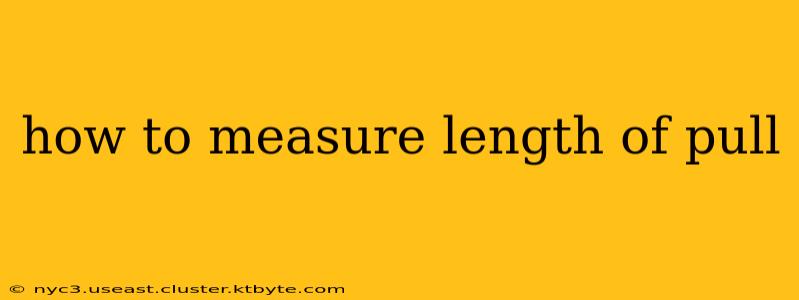Accurately measuring your firearm's length of pull (LOP) is crucial for comfortable and effective shooting. An incorrect LOP can lead to discomfort, poor accuracy, and even injury. This guide provides a step-by-step process for measuring your LOP, explaining different methods and considerations for different firearm types.
Understanding Length of Pull
Length of pull refers to the distance between the trigger face and the rearmost point of the buttstock where it meets your shoulder. It's a critical dimension affecting shooting posture and control. A properly fitted LOP allows for a natural and consistent cheek weld, reducing flinching and improving accuracy.
Methods for Measuring Length of Pull
There are several ways to measure length of pull, each with its own advantages and disadvantages:
1. Using a Ruler or Tape Measure: The Simple Method
This is the most straightforward approach, requiring only a ruler or tape measure.
Steps:
- Position the Firearm: Rest the firearm on a flat, stable surface. Ensure the stock is lying flat.
- Identify Measurement Points: Locate the trigger face and the rearmost point of the buttstock.
- Measure the Distance: Place the ruler or tape measure's zero point against the trigger face and extend it to the rearmost point of the buttstock.
- Record the Measurement: Note the measurement in inches or centimeters.
Considerations: This method is simple but might lack precision, especially for firearms with curved buttstocks.
2. Using a Length of Pull Gauge: The Precise Method
A dedicated length of pull gauge provides a more accurate measurement, particularly for firearms with complex stock shapes. These gauges usually have a sliding mechanism that conforms to the buttstock's contour.
Steps:
- Position the Gauge: Place the gauge against the trigger face and buttstock.
- Adjust and Measure: Slide the gauge's measuring arm until it firmly contacts the buttstock's rearmost point.
- Read the Measurement: The gauge will display the LOP directly.
Considerations: Requires purchasing a length of pull gauge.
3. Measuring for Custom Stock Fitting: The Advanced Method
If you're having a custom stock made or significantly altering an existing one, a more precise method involving body measurements is needed. This often involves professional gun fitting services. They'll measure your body's dimensions related to posture and shoulder alignment to determine the optimal LOP.
Considerations: Requires specialized tools and expertise.
Factors to Consider
- Type of Firearm: The method you choose may depend on the firearm type. For example, measuring the LOP of a shotgun with a pistol grip will differ slightly from measuring a rifle with a Monte Carlo stock.
- Stock Material: The material of the buttstock (wood, synthetic, etc.) may slightly affect the measurement.
- Recoil Pad: The thickness of the recoil pad must be considered when measuring the LOP. Some measurements include the pad thickness; others don't. Clarify this beforehand.
- Clothing: Be mindful of the clothing you are wearing. Thick layers of clothing can affect the effective LOP.
Optimizing Your Length of Pull
Once you've determined your LOP, you may need to adjust it for optimal comfort and accuracy. This might involve:
- Adding or Removing Recoil Pads: Modifying the recoil pad's thickness is a common way to alter the LOP.
- Custom Stock Work: For a more precise adjustment, consider having a gunsmith modify the stock.
- Adjustable Stocks: Many modern firearms offer adjustable stocks allowing for customized LOP adjustments without requiring modification.
By following these methods and considerations, you can accurately measure your firearm’s length of pull and ensure a comfortable and accurate shooting experience. Remember to always prioritize safety when handling firearms.

